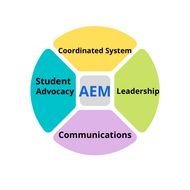Advocating for my AEM Workbook
(View Complete Item Description)Advocating For My Accessible Educational Materials (AEM) is a workbook designed for students to use as they begin to learn to advocate for the accommodations and accessibility features they need in their educational programs. It applies common self-advocacy principles to the needs of students who use AEM in their daily educational programs. Students and their support teams will find this guide useful when an assessment has been completed to establish the need for accessible educational materials, technology, and assistive technology. In creating this workbook, the authors have assumed that the student is already using their AEM in functional ways in their educational environments. Because students can start building self-advocacy skills as soon as they begin to use AEM, individual sections of the workbook may be useful as soon as students begin to learn to use AEM.
Material Type: Student Guide















